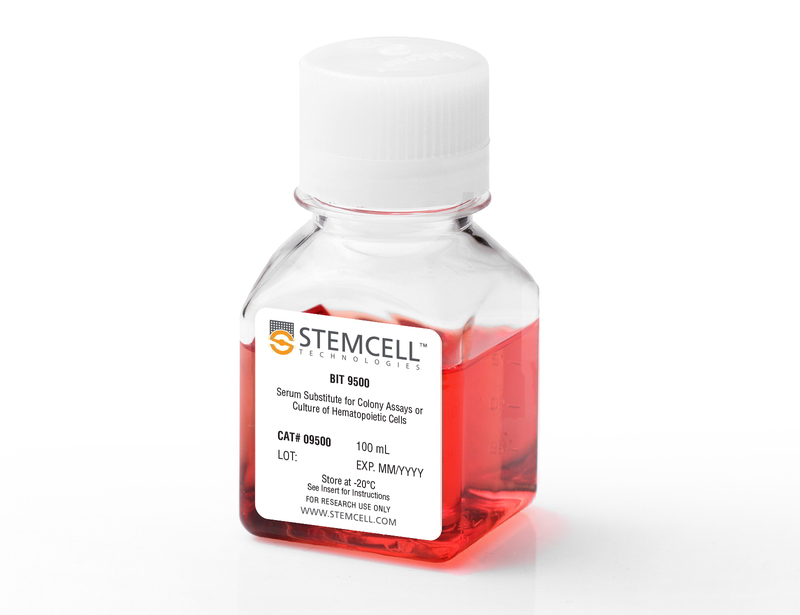概要
BIT 9500 Serum Substitute has been developed for use in applications where a serum-free culture medium of defined composition is required. This product contains bovine serum albumin (BSA), insulin, and transferrin (BIT) in Iscove’s MDM. It contains pre-screened batches of BSA that have been selected to support the optimal growth of human hematopoietic progenitor cells in serum-free media formulations. It is also suitable for the culture of mouse hematopoietic progenitor cells in serum-free conditions.
技术资料
| Document Type | 产品名称 | Catalog # | Lot # | 语言 |
|---|---|---|---|---|
| Product Information Sheet | BIT 9500 Serum Substitute | 09500 | All | English |
| Safety Data Sheet | BIT 9500 Serum Substitute | 09500 | All | English |
数据及文献
Publications (47)
Cell stem cell 2019 may
Single-Cell Proteomics Reveal that Quantitative Changes in Co-expressed Lineage-Specific Transcription Factors Determine Cell Fate.
Abstract
Abstract
Hematopoiesis provides an accessible system for studying the principles underlying cell-fate decisions in stem cells. Proposed models of hematopoiesis suggest that quantitative changes in lineage-specific transcription factors (LS-TFs) underlie cell-fate decisions. However, evidence for such models is lacking as TF levels are typically measured via RNA expression rather than by analyzing temporal changes in protein abundance. Here, we used single-cell mass cytometry and absolute quantification by mass spectrometry to capture the temporal dynamics of TF protein expression in individual cells during human erythropoiesis. We found that LS-TFs from alternate lineages are co-expressed, as proteins, in individual early progenitor cells and quantitative changes of LS-TFs occur gradually rather than abruptly to direct cell-fate decisions. Importantly, upregulation of a megakaryocytic TF in early progenitors is sufficient to deviate cells from an erythroid to a megakaryocyte trajectory, showing that quantitative changes in protein abundance of LS-TFs in progenitors can determine alternate cell fates.
Blood 2017 MAR
Identification of unipotent megakaryocyte progenitors in human hematopoiesis.
Abstract
Abstract
The developmental pathway for human megakaryocytes remains unclear and the definition of pure unipotent megakaryocyte progenitor is still controversial. Using single-cell transcriptome analysis, we have identified a cluster of cells within immature hematopoietic stem and progenitor cell populations that specifically express genes related to the megakaryocyte lineage. We used CD41 as a positive marker to identify these cells within the CD34(+)CD38(+)IL-3Rα(dim)CD45RA(-) common myeloid progenitor (CMP) population. These cells lacked erythroid and granulocyte/macrophage potential, but exhibited robust differentiation into the megakaryocyte lineage at a high frequency, both in vivo and in vitro The efficiency and expansion potential of these cells exceeded those of conventional bipotent megakaryocyte/erythrocyte progenitors. Accordingly, the CD41(+) CMP was defined as a unipotent megakaryocyte progenitor (MegP) that is likely to represent the major pathway for human megakaryopoiesis, independent of canonical megakaryocyte-erythroid lineage bifurcation. In the bone marrow of patients with essential thrombocythemia, the MegP population was significantly expanded in the context of a high burden of Janus kinase 2 mutations. Thus, the prospectively isolatable and functionally homogeneous human MegP will be useful for the elucidation of the mechanisms underlying normal and malignant human hematopoiesis.
The Annals of thoracic surgery 2014 NOV
Enhanced lung epithelial specification of human induced pluripotent stem cells on decellularized lung matrix.
Abstract
Abstract
BACKGROUND Whole-lung scaffolds can be created by perfusion decellularization of cadaveric donor lungs. The resulting matrices can then be recellularized to regenerate functional organs. This study evaluated the capacity of acellular lung scaffolds to support recellularization with lung progenitors derived from human induced pluripotent stem cells (iPSCs). METHODS Whole rat and human lungs were decellularized by constant-pressure perfusion with 0.1% sodium dodecyl sulfate solution. Resulting lung scaffolds were cryosectioned into slices or left intact. Human iPSCs were differentiated to definitive endoderm, anteriorized to a foregut fate, and then ventralized to a population expressing NK2 homeobox 1 (Nkx2.1). Cells were seeded onto slices and whole lungs, which were maintained under constant perfusion biomimetic culture. Lineage specification was assessed by quantitative polymerase chain reaction and immunofluorescent staining. Regenerated left lungs were transplanted in an orthotopic position. RESULTS Activin-A treatment, followed by transforming growth factor-$\$, induced differentiation of human iPSCs to anterior foregut endoderm as confirmed by forkhead box protein A2 (FOXA2), SRY (Sex Determining Region Y)-Box 17 (SOX17), and SOX2 expression. Cells cultured on decellularized lung slices demonstrated proliferation and lineage commitment after 5 days. Cells expressing Nkx2.1 were identified at 40% to 60% efficiency. Within whole-lung scaffolds and under perfusion culture, cells further upregulated Nkx2.1 expression. After orthotopic transplantation, grafts were perfused and ventilated by host vasculature and airways. CONCLUSIONS Decellularized lung matrix supports the culture and lineage commitment of human iPSC-derived lung progenitor cells. Whole-organ scaffolds and biomimetic culture enable coseeding of iPSC-derived endothelial and epithelial progenitors and enhance early lung fate. Orthotopic transplantation may enable further in vivo graft maturation.
Journal of immunology (Baltimore, Md. : 1950) 2011 MAY
Attenuated Bordetella pertussis vaccine candidate BPZE1 promotes human dendritic cell CCL21-induced migration and drives a Th1/Th17 response.
Abstract
Abstract
New vaccines against pertussis are needed to evoke full protection and long-lasting immunological memory starting from the first administration in neonates--the major target of the life-threatening pertussis infection. A novel live attenuated Bordetella pertussis vaccine strain, BPZE1, has been developed by eliminating or detoxifying three important B. pertussis virulence factors: pertussis toxin, dermonecrotic toxin, and tracheal cytotoxin. We used a human preclinical ex vivo model based on monocyte-derived dendritic cells (MDDCs) to evaluate BPZE1 immunogenicity. We studied the effects of BPZE1 on MDDC functions, focusing on the impact of Bordetella-primed dendritic cells in the regulation of Th and suppressor T cells (Ts). BPZE1 is able to activate human MDDCs and to promote the production of a broad spectrum of proinflammatory and regulatory cytokines. Moreover, conversely to its parental wild-type counterpart BPSM, BPZE1-primed MDDCs very efficiently migrate in vitro in response to the lymphatic chemokine CCL21, due to the inactivation of pertussis toxin enzymatic activity. BPZE1-primed MDDCs drove a mixed Th1/Th17 polarization and also induced functional Ts. Experiments performed in a Transwell system showed that cell contact rather than the production of soluble factors was required for suppression activity. Overall, our findings support the potential of BPZE1 as a novel live attenuated pertussis vaccine, as BPZE1-challenged dendritic cells might migrate from the site of infection to the lymph nodes, prime Th cells, mount an adaptive immune response, and orchestrate Th1/Th17 and Ts responses.
Blood 2011 MAY
The c-Myb target gene neuromedin U functions as a novel cofactor during the early stages of erythropoiesis.
Abstract
Abstract
The requirement of c-Myb during erythropoiesis spurred an interest in identifying c-Myb target genes that are important for erythroid development. Here, we determined that the neuropeptide neuromedin U (NmU) is a c-Myb target gene. Silencing NmU, c-myb, or NmU's cognate receptor NMUR1 expression in human CD34(+) cells impaired burst-forming unit-erythroid (BFU-E) and colony-forming unit-erythroid (CFU-E) formation compared with control. Exogenous addition of NmU peptide to NmU or c-myb siRNA-treated CD34(+) cells rescued BFU-E and yielded a greater number of CFU-E than observed with control. No rescue of BFU-E and CFU-E growth was observed when NmU peptide was exogenously added to NMUR1 siRNA-treated cells compared with NMUR1 siRNA-treated cells cultured without NmU peptide. In K562 and CD34(+) cells, NmU activated protein kinase C-βII, a factor associated with hematopoietic differentiation-proliferation. CD34(+) cells cultured under erythroid-inducing conditions, with NmU peptide and erythropoietin added at day 6, revealed an increase in endogenous NmU and c-myb gene expression at day 8 and a 16% expansion of early erythroblasts at day 10 compared to cultures without NmU peptide. Combined, these data strongly support that the c-Myb target gene NmU functions as a novel cofactor for erythropoiesis and expands early erythroblasts.
Blood 2011 MAY
Erythropoietin couples erythropoiesis, B-lymphopoiesis, and bone homeostasis within the bone marrow microenvironment.
Abstract
Abstract
Erythropoietin (Epo) has been used in the treatment of anemia resulting from numerous etiologies, including renal disease and cancer. However, its effects are controversial and the expression pattern of the Epo receptor (Epo-R) is debated. Using in vivo lineage tracing, we document that within the hematopoietic and mesenchymal lineage, expression of Epo-R is essentially restricted to erythroid lineage cells. As expected, adult mice treated with a clinically relevant dose of Epo had expanded erythropoiesis because of amplification of committed erythroid precursors. Surprisingly, we also found that Epo induced a rapid 26% loss of the trabecular bone volume and impaired B-lymphopoiesis within the bone marrow microenvironment. Despite the loss of trabecular bone, hematopoietic stem cell populations were unaffected. Inhibition of the osteoclast activity with bisphosphonate therapy blocked the Epo-induced bone loss. Intriguingly, bisphosphonate treatment also reduced the magnitude of the erythroid response to Epo. These data demonstrate a previously unrecognized in vivo regulatory network coordinating erythropoiesis, B-lymphopoiesis, and skeletal homeostasis. Importantly, these findings may be relevant to the clinical application of Epo.

 网站首页
网站首页



